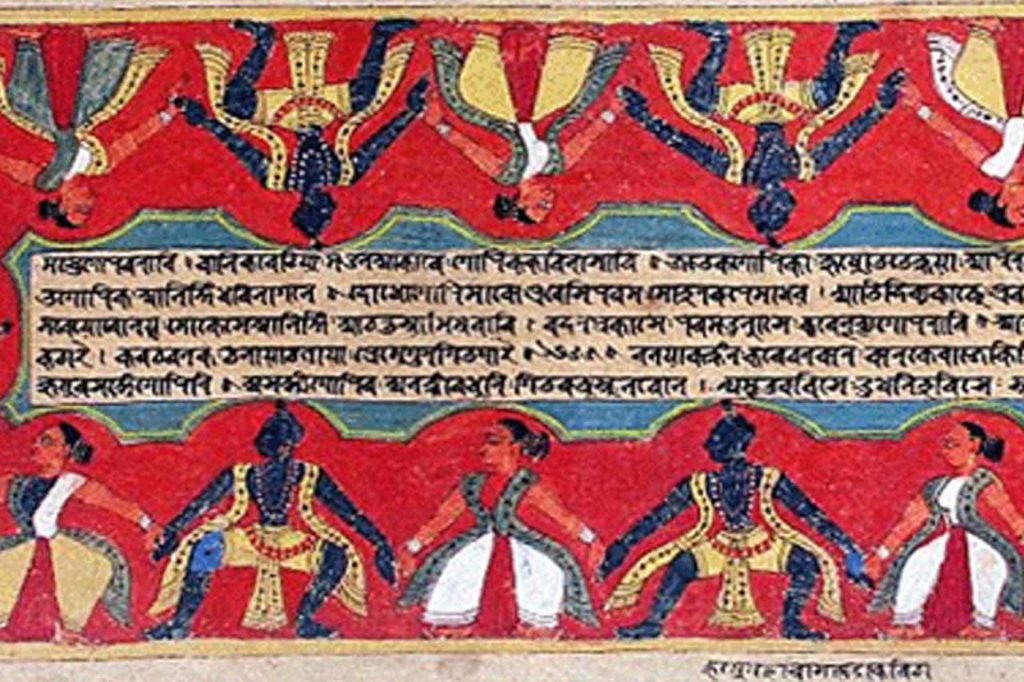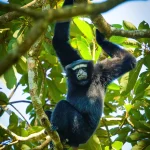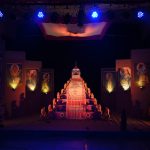Srimanta Sankaradeva was one of the foremost religious philosophers in the world. His religion Eka Sharana Nâma Dharma had laid the foundation for a new religious philosophy though he had not made any conscious effort to that end. The religious philosophy preached by Srimanta Sankaradeva had its genesis in the Veda. Many people misconstrued it in his life-time itself and even took him to task. There were royal persecutions too on this very issue. An Ahom king Chuhungmung and a Koch king Naranârâyana tried the saint for alleged attempt to destroy religion in the society. But the saint came out unscathed in all those crises, since he could convince all concerned that his ideology of Eka Sharana Nâma Dharma was actually rooted in the Veda.
There are many explicit references to the Vedas in Srimanta Sankaradeva’s own writings. One such instance is the chapter Veda-stuti in his magnum opus Kîrtana-ghoshâ. It is categorically said here that Nârâyana or Hari is the ultimate truth elaborated by the Veda.
Hridisthita kari Hari samprati tomâka
Karoho upâsâ âmi save Vedajâka
(Kîrtana-ghoshâ/1655)
Srimanta Sankaradeva also said that only those devotees, who uttered the name of Hari understood the Veda properly.
Sehise kulîna Vedaka buje
Jâhâra mukhe Hari-nâma sije
(Kîrtana-ghoshâ/112)
Srimanta Sankaradeva glorified the Vedas in many places of his innumerable writings. He advised people to follow the path of the Vedas. Those people who violated the instructions of the Vedas were termed as unmeritoreous while those people who abided by the Vedas were termed meritoreous.
Vedara bihita satate âcharoi
Sehijana punyavanta
Vedara nisiddha koroi jito nare
Sehito pâpi atyanta
(Bhâgavata/6/137)
Srimanta Sankaradeva also said that the Vedas were nothing but sayings of Krishna. This put the Vedas in the same level as Bhâgavata in Eka Sharana Nâma Dharma.
Vede bihoi jâka jâniba sakale
Krishnarese âjna bânî
(Bhâgavata/6/139)
In order to explore the similarity of Srimanta Sankaradeva’s ideology with the Vedic thoughts, we will have to analyse the Purusha-sukta of Rigveda. The Purusha-sukta of Rigveda is an important exposition on Brahma. It says that the ultimate Purusha pervades every entity, both sentient and insentient beings. He is the past and present of every thing and the controller of all beings. This universe is his attribute. He can be known by surmounting ignorance. So he is the Paramâtmâ. All deities emanate from him.1 Actually all these deities are nothing but metaphorical representation of the nature. This is explained beautifully by the Bâgambrini-sukta of Rigveda.2 So the Vedic idea about the deities is the same as that of Srimanta Sankaradeva, who considered the deities as subservient to the supreme God. That the Eka Sharana Nâma Dharma is also known as Mahâpurushîyâ Dharma is significant in this context. This nomenclature itself means that Srimanta Sankaradeva preached devotion and allegiance to one supreme absolute entity in the foot-step of Purusha-sukta of Rigveda.
Another important feature of the Purusha-sukta is that it placed Vâsudeva in the highest pedestal, which was also what Srimanta Sankaradeva did. According to the Purusha-sukta, the universe emanated from Vâsudeva, which means that Vâsudeva is the supreme God.3 Vâsudeva is none but Krishna. Vâsudeva means son of Vasudeva. In other words Vâsudeva means Krishna. That is why Krishna is worshipped as the supreme God in the Eka Sharana Nâma Dharma.
Vishnu is the same as Brahma in Veda. Sruti defined Brahma as Vishnu, according to Madhvâcârya.4 Srimanta Sankaradeva also maintained a similar view. He said that God and Brahma was the same.
According to Veda, the living beings are nothing but Brahma. It is said, Jîva Brahmaiba nâpara. Srimanta Sankaradeva also maintained a similar view. He said that the living beings were nothing but play of God.5 This is in tune with the Vedic concept about creation. The holy scripture Srimadbhagavadgîtâ, which was essence of Veda, said that the creation happened due to Mâyâ. Mâyâ in turn was an attribute of Vishnu, according to Bhâgavata, another scripture based on Veda.6 Thus Srimanta Sankaradeva’s ideology was in tune with that of Srimadbhagavadgîtâ and Bhâgavata. So we have seen that the impact of Veda on Srimanta Sankaradeva was conveyed mostly through Srimadbhagavadgîtâ and Bhâgavata. Very few people know that the concept of Bhakti enunciated in Bhâgavata arose from Veda. In fact the concept of Bhakti was embedded in the Vedic literature.7
A section of people say that Srimanta Sankaradeva’s ideology was contrary to Veda, because he opposed sacrifice of animals before the deities. But the Purusha-sukta categorically says that Yajna is a mental concept. It asks people to sacrifice the animal instincts within themselves.8 It was later distorted to external form, whereupon animals started to be sacrificed instead of the animal instincts within oneself. Srimanta Sankaradeva also preached in a similar vein, according to the hagiographies. Once he asked Madhavadeva to fetch a beast, but without using any arrow. Moreover the beast must be neither alive nor dead, it was pointed out. Srimanta Sankaradeva also asked his disciple strictly not to come without the beast. The next day Madhavadeva submitted himself as the human-beast, whereupon Srimanta Sankaradeva praised Madhavadeva profusely.9 This proves concurrence of Srimanta Sankaradeva with the Vedic ideology. Madhavadeva understood that his preceptor had asked him to sacrifice the animal instincts within himself. The beast was within oneself and one needed to understand that.
Srimanta Sankaradeva did not approve of animal sacrifice or for that matter any type of worship performed with selfish desires. His ideology was that of Nigama path or the path of selfless works. He did not approve of the Âgama path or the path of selfish works, since that path led to damnation of the soul in hell, a metaphor for unhappiness caused by unfulfilled desires. It may be mentioned that the concept of Naraka or hell is an integral part of Indian mythology. Contrary to that, Srimanta Sankaradeva’s entire philosophy was targeted at lifting the soul through different phases to the supreme non-dual state. That is why we have termed it as Vivartanavâda.10 The mention of ten incarnations of God in Srimanta Sankaradeva’s Kirtana Ghoshâ also is quite significant in this respect.
References and notes :
1. Sankaradevar darshan, Bapchandra Mahanta, First complete edition, Jorhat, 1995 AD, pp. 14-15. In later period, this Purusha started to be called as Purushottama or Parama Purusha in order to differentiate it from Jivâtmâ.
2. Bapchandra Mahanta, Op cit, 1995 AD, p. 12.
3. Ibid, p. 16.
4. Madhvâcârya and Sankaradeva, Rajendra Nath Sarma, in Prâcya Prajnâ, edited by Amalendu Chakravarty, Vol III, Guwahati, 2000 AD, p 36.
5. Anâdi pâtana, Srimanta Sankaradeva, verse 14.
6. Mâyâ as viewed by Sankarâcârya and Sankaradeva : a comparative study, Amalendu Chakravarty, in Prâcya Prajnâ, edited by Amalendu Chakravarty, Vol III, Guwahati, 2000 AD, pp 12-13. According to Rabindranath Tagore, the monists distorted the Vedic concept on Mâyâ by instituting the worship of Mahâmâyâ in the form of Kâli, Durgâ etc and placing it above the Lord of cosmic energy, the Brahma. [Ibid, p. 17.]
7. Vaisnavism, Saivism and Minor Religious Systems, R. G. Bhandarkar, Varanasi, 1965 AD, pp 28-30.
8. Bapchandra Mahanta, Op cit, 1995 AD, p. 17.
9. Kathâ Gurucharit, Chakrapani Vairagi, composed in about 1758 AD, edited by Upendra Chandra Lekharu, 15th edition, Guwahati, 1987 AD, pp. 104-105.
10. The unique philosophy of Srimanta Sankaradeva, Dr Sanjib Kumar Borkakoti, in Mahâpurusa Jyoti, Journal of Srimanta Sankaradeva Sangha, edited by Dr. Suresh Chandra Bora, Volume IV, Nagaon 2002 AD, pp. 82-85; Srimanta Sankaradevar darshan, Dr Sanjib Kumar Borkakoti, in Âjir Batori, edited by D.N.Chakravarty, Guwahati, March 12, 1999 AD.
Acknowledgement :
This article was earlier published in the website www.sankaradeva.com




